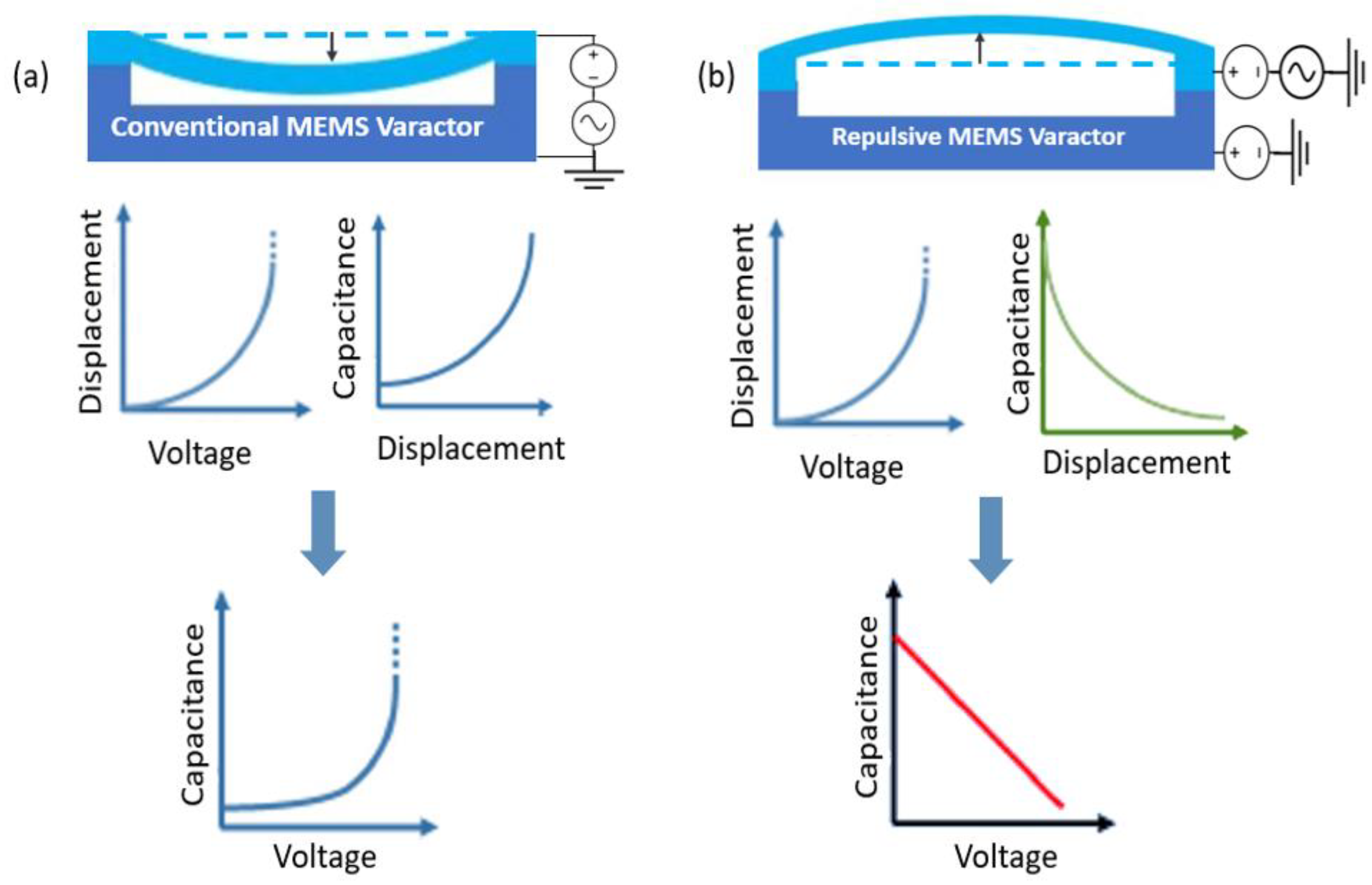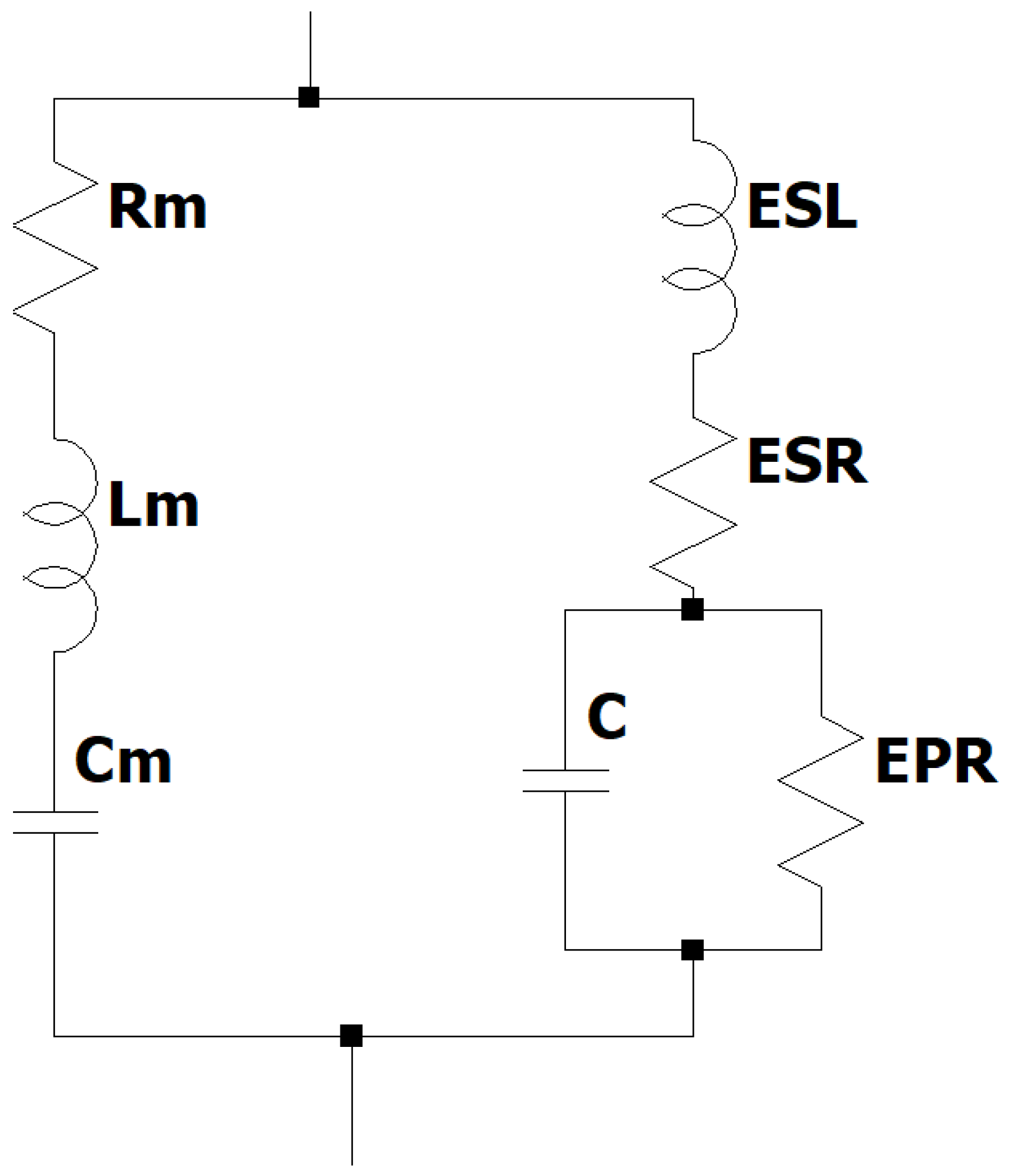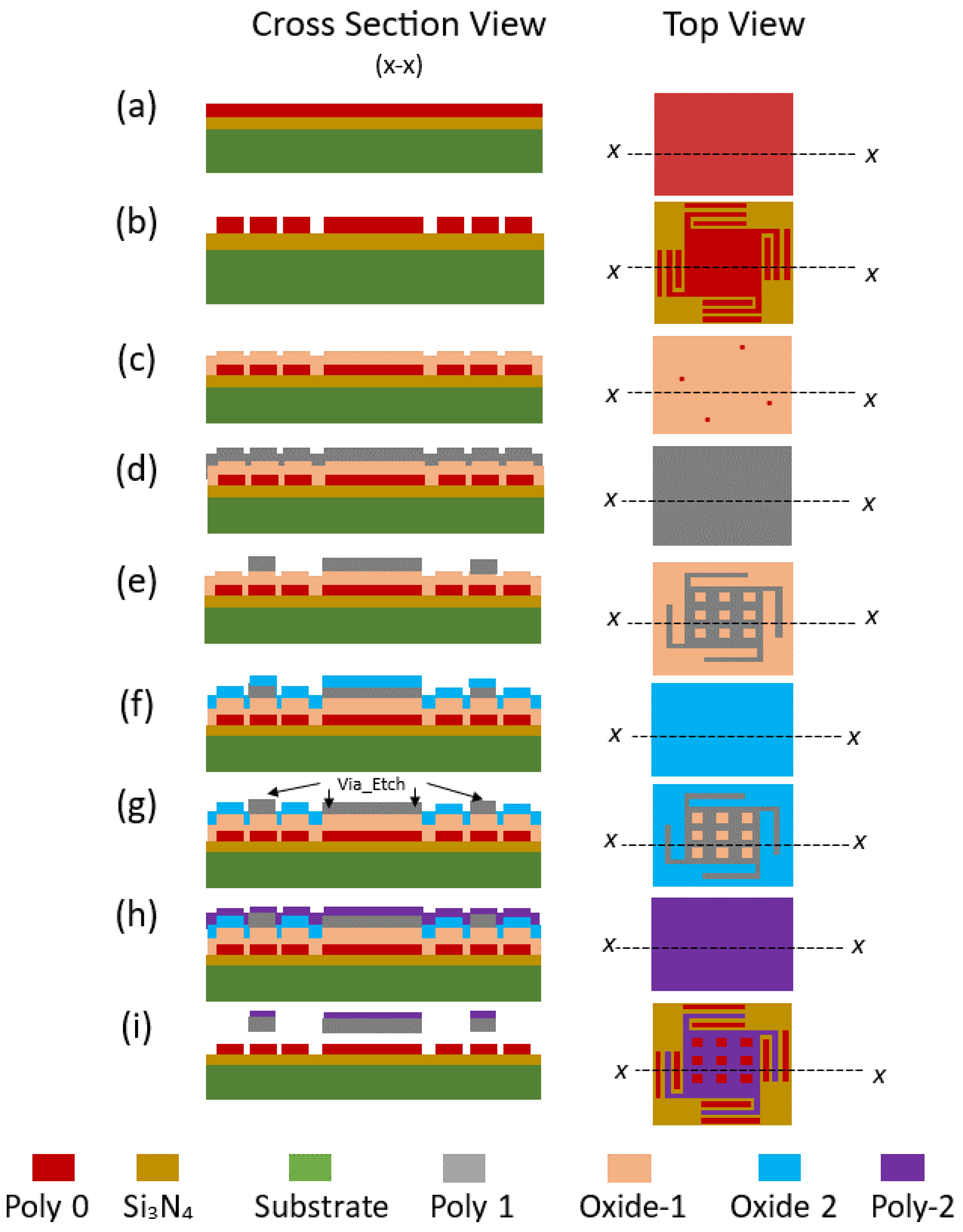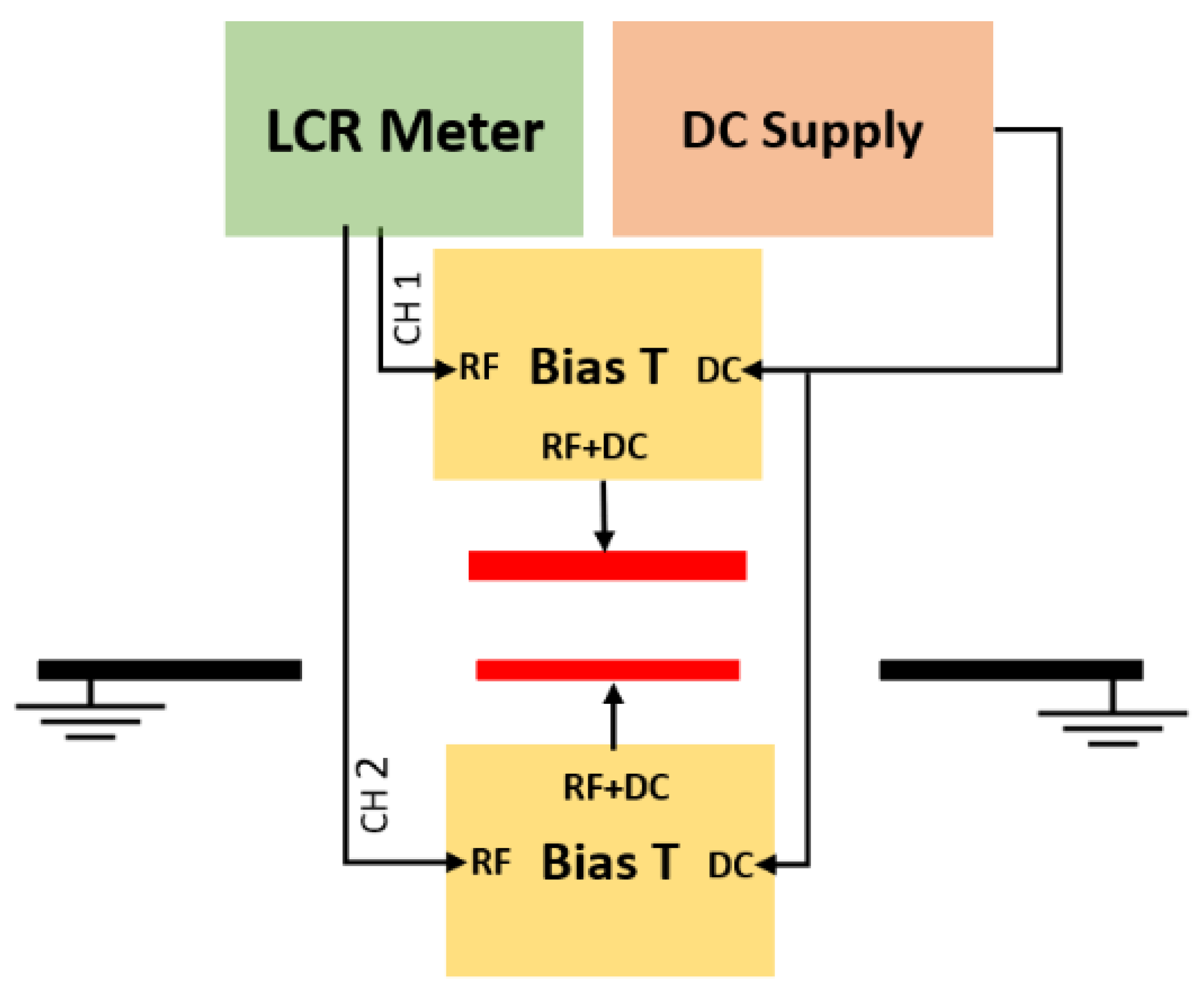Enhancing Linearity in Parallel-Plate MEMS Varactors through Repulsive Actuation
Abstract
:1. Introduction
2. Design Methodology
2.1. Concept
2.2. Fabrication
3. Characterization and Results
4. Conclusions
Author Contributions
Funding
Data Availability Statement
Acknowledgments
Conflicts of Interest
References
- Lázaro, A.; Girbau, D.; Pradell, L. Distortion produced by RF MEMS varactors on digital communication signals. Microw. Opt. Technol. Lett. 2006, 48, 246–249. [Google Scholar] [CrossRef]
- Quintero, A.; Cardes, F.; Perez, C.; Buffa, C.; Wiesbauer, A.; Hernandez, L. A VCO-based CMOS readout circuit for capacitive MEMS microphones. Sensors 2019, 19, 4126. [Google Scholar] [CrossRef] [PubMed]
- Salvia, J.C.; Melamud, R.; Chandorkar, S.A.; Lord, S.F.; Kenny, T.W. Real-time temperature compensation of mems oscillators using an integrated micro-oven and a phase-locked loop. J. Microelectromechanical Syst. 2010, 19, 192–201. [Google Scholar] [CrossRef]
- Khan, F.; Younis, M.I. RF MEMS electrostatically actuated tunable capacitors and their applications: A review. J. Micromechanics Microengineering 2022, 32, 19. [Google Scholar] [CrossRef]
- Rebeiz, G.M.; Dussopt, L. RF MEMS: Theory, Design, and Technology; John Wiley & Sons: Hoboken, NJ, USA, 2003. [Google Scholar]
- Shaheen, S.; Saleem, M.M.; Zaidi, S.M.T. Design and FEM Modeling of an Electrostatic RFMEMS Varactor. In Proceedings of the International Conference on Computing, Electronic and Electrical Engineering, Quetta, Pakistan, 12–13 November 2018. [Google Scholar]
- Elshurafa, A.; Ho, P.; Salama, K.N. Low voltage RF MEMS variable capacitor with linear C-V response. Electron. Lett. 2012, 48, 392–393. [Google Scholar] [CrossRef]
- Chen, K.; Kovacs, A.; Peroulis, D. Anti-biased RF MEMS varactor topology for 20–25 dB linearity enhancement. In Proceedings of the 2010 IEEE MTT-S International Microwave Symposium, Anaheim, CA, USA, 23–28 May 2010. [Google Scholar]
- Roy, A.L.; Bhattacharya, A.; Chaudhuri, R.R.; Bhattacharyya, T.K. Analysis of the Pull-In Phenomenon in Microelectromechanical Varactors. In Proceedings of the 25th International Conference on VLSI Design, Hyderabad, India, 7–11 January 2012. [Google Scholar]
- Chang-Hoon, H.; Dong-Hoon, C.; Jun-Bo, Y. Parallel-Plate MEMS Variable Capacitor With Superior Linearity and Large Tuning Ratio Using a Levering Structure. J. Microelectromechanical Syst. 2011, 20, 1345–1354. [Google Scholar]
- Chang-Hoon, H.; Dong-Hoon, C.; Seon-Jin, C. MEMS variable capacitor with superior linearity and large tuning ratio by moving the plate to the increasing-gap direction. In Proceedings of the IEEE 24th International Conference on Micro Electro Mechanical Systems, Cancun, Mexico, 23–27 January 2011. [Google Scholar]
- Barrière, F.; Passerieux, D.; Mardivirin, D.; Pothier, A.; Blondy, P. An inverted-gap analog tuning RF-MEMS capacitor with 250 milliwatts power handling capability. In Proceedings of the International Conference on Micro Electro Mechanical Systems (MEMS), Paris, France, 29 January 2012–2 February 2012. [Google Scholar]
- Shavezipur, M.; Khajepour, A.; Hashemi, S.M. Development of novel segmented-plate linearly tunable MEMS capacitors. J. Micromechanics Microengineering 2008, 18, 035035. [Google Scholar] [CrossRef]
- Aryal, N.; Emadi, A. A Method to Enhance Stroke Level of a MEMS Micromirror with Repulsive Electrostatic Force. Micromachines 2020, 11, 401. [Google Scholar] [PubMed]
- He, S.; Mrad, R.B. Design, Modeling, and Demonstration of a MEMS Repulsive-Force Out-of-Plane Electrostatic Micro Actuator. J. Microelectromechanical Syst. 2008, 17, 532–547. [Google Scholar]
- Weimin, W.; Qiang, W.; Hao, R.; Wenying, M.; Chuankai, Q.; Zexiang, C.; Bin, F. Electrostatic repulsive out-of-plane actuator using conductive substrate. Sci. Rep. 2016, 6, 35118. [Google Scholar]
- Cowen, A.; Hardy, B.; Mahadevan, R.; Wilcenski, S. PolyMUMPs Design Handbook; MEMSCAP: Bernin, France, 2011. [Google Scholar]










| Structure | Length (μm) | Width (μm) | Resistance (Ω) |
|---|---|---|---|
| Membrane | 100 | 100 | 6.67 |
| Anchored Beam | 85 | 16 | 35.42 |
| Beam to Membrane Interconnect | 17.5 | 16 | 7.29 |
| Reference | Linearity Factor | Pull-in Limitations | Varactor Area (mm²) | Min Measured Capacitance | Max Measured Capacitance | Tuning Range Factor | Membrane Movement Direction |
|---|---|---|---|---|---|---|---|
| [6] | 96.07% | Yes | 2.25 | 0.45 pF | 1.125 pF | 1.6 | +Z |
| [7] | 98.50% | Yes | 0.068 | 0.75 pF | 0.9 pF | 0.2 | −Z |
| [10] | 98.40% | Yes | 0.16 | 0.42 pF | 1.05 pF | 1.34 | +Z |
| [11] | 99.10% | Yes | 0.16 | 0.5 pF | 1.3 pF | 1.78 | +Z |
| [12] | 96.20% | Yes | − | 60 fF | 235 fF | 2.92 | +Z |
| [13] | 99.00% | Yes | 0.16 | 0.51 pF | 0.8 pF | 0.57 | −Z |
| This Work | 99.70% | No | 0.031 | 8.5 fF | 110 fF | 11.94 | +Z |
Disclaimer/Publisher’s Note: The statements, opinions and data contained in all publications are solely those of the individual author(s) and contributor(s) and not of MDPI and/or the editor(s). MDPI and/or the editor(s) disclaim responsibility for any injury to people or property resulting from any ideas, methods, instructions or products referred to in the content. |
© 2023 by the authors. Licensee MDPI, Basel, Switzerland. This article is an open access article distributed under the terms and conditions of the Creative Commons Attribution (CC BY) license (https://creativecommons.org/licenses/by/4.0/).
Share and Cite
Bensalem, R.; Elsayed, M.Y.; Tawfik, H.H.; Nabki, F.; El-Gamal, M.N. Enhancing Linearity in Parallel-Plate MEMS Varactors through Repulsive Actuation. Micro 2023, 3, 811-821. https://doi.org/10.3390/micro3040057
Bensalem R, Elsayed MY, Tawfik HH, Nabki F, El-Gamal MN. Enhancing Linearity in Parallel-Plate MEMS Varactors through Repulsive Actuation. Micro. 2023; 3(4):811-821. https://doi.org/10.3390/micro3040057
Chicago/Turabian StyleBensalem, Roufaida, Mohannad Y. Elsayed, Hani H. Tawfik, Frederic Nabki, and Mourad N. El-Gamal. 2023. "Enhancing Linearity in Parallel-Plate MEMS Varactors through Repulsive Actuation" Micro 3, no. 4: 811-821. https://doi.org/10.3390/micro3040057






